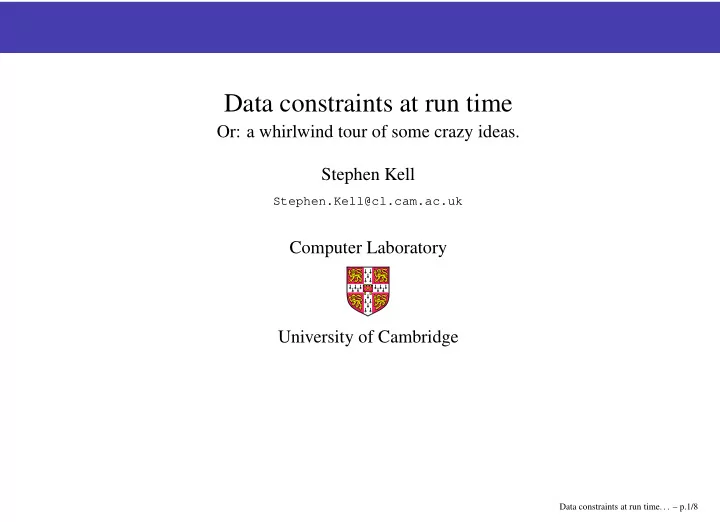

Data constraints at run time Or: a whirlwind tour of some crazy ideas. Stephen Kell Stephen.Kell@cl.cam.ac.uk Computer Laboratory University of Cambridge Data constraints at run time. . . – p.1/8
Why run time? Type systems, static analysis etc. are great, but � need to cope with heterogeneity � run-time is a great unifier � run-time is a necessary “last station” (for checking, ...) � dynamic analysis is cheaper than ever (multicore) Data constraints at run time. . . – p.2/8
Crazy idea 1: consistency in transactional memory try { tx.BeginTransaction(); // txnl code done = tx.CommitTransaction(); } catch (AbortException e) { /* ... */} Transactional code + data constraints = ? � current TMs are not ACID (just A I ) � problem: performance! � rejoinder 1: treat it like assert() —can turn off � rejoinder 2: manycore might make this irrelevant � worth investigating added actual performance costs Data constraints at run time. . . – p.3/8
Idea 2: using data constraints in debuggers Known data constraints are gold when debugging. � programmer knows where consistency is expected � debuggers can automate search for violations (if...) Requires debugging information which records data constraints � either programmer-provided (in-band, of out-of-)... � ... or perhaps derived (from analysis, ...) � we will see more reasons why this is a good fit... Data constraints at run time. . . – p.4/8
Crazy idea 3a: mining disk ↔ memory lenses Lots of software uses ad-hoc data formats. � config files, logs, undocumented file formats, ... � some too complex to be learnable from data alone Use the programs themselves to mine the file formats. � might use static analysis sensitive to filesystem calls � but: lots of source languages (incl. Perl, sed, ...) � might simply analyse traces (harder) � of file accesses, branch instructions � of primitive translations (e.g. atoi() , sscanf() , et al) � structure is latent in trace—can use PADS-like algorithm? Data constraints at run time. . . – p.5/8
Crazy idea 3b: sharing the constraints around Suppose we know constraints for file format, but not the corresponding in-memory data—or vice-versa. � i.e. one or other documented, but not both � want to share these around � idea: propagate constraints through lenses Useful: debug info can describe both disk and mem formats � (with some minor extensions) � (bonus: already have tools for writing such lenses manually) Data constraints at run time. . . – p.6/8
(Slightly off-topic) idea 4: using lenses to save memory Memory remains scarce (unlike CPU time...). � Consider a program reading in some large files. � Given disk ↔ mem lenses... � can discard replicas, even non-verbatim (transformed) � ... when computational distance is small Generalises from existing memory-saving approaches � web cache design: explicit disk ↔ mem transfer is bad � also avoids bad interaction with demand paging � only works when disk/mem reps are verbatim • cf. small computational distance � page-sharing work (Satori, Difference Engine, ...) Data constraints at run time. . . – p.7/8
Conclusions We’ve seen a few runtime-centric ideas about data. � mostly easily added to existing tools � mostly under-thought! Message: extending runtimes is good � static analysis innovations need dynamic complement � propagate innovations into shared infrastructure... � ... establishing commonality in the process Subliminal message: debug info is a good place to innovate � mediates language and runtime views � can capture persistent and in-memory representations Data constraints at run time. . . – p.8/8
Recommend
More recommend